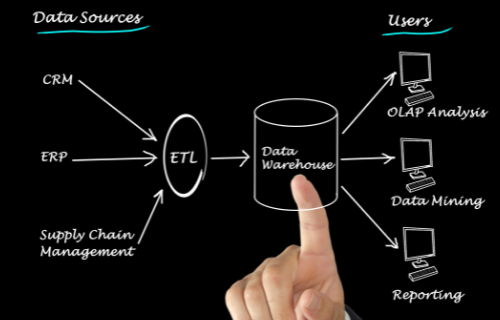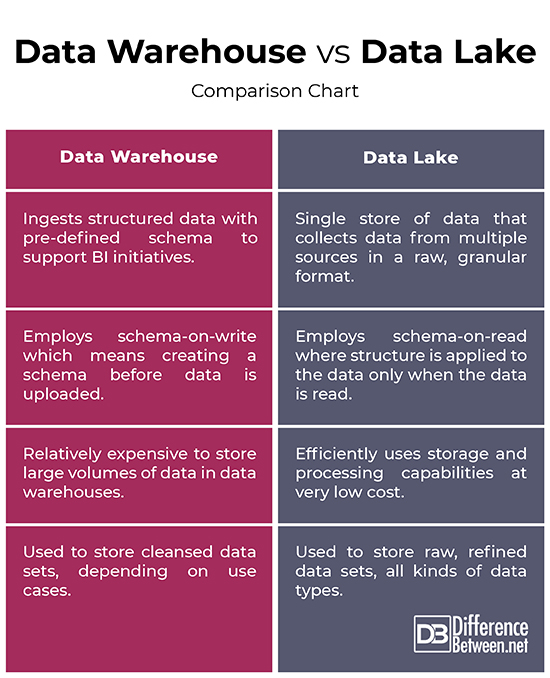Difference Between Data Warehouse and Data Lake
Depending on any organization’s functional requirements, they will require both a data lake and a data warehouse. Each serves different purposes and use cases. Apart from that, both are widely used for storing big data, but they cannot be used interchangeably. Both are often confused with each other but are very much different than they are alike. We take a look at some key differences between the two.

Data Warehouse
A data warehouse is exactly what it sounds like – a warehouse for your high-value data or data assets that come from other corporate applications. It is a data management system used to store a large collection of business data that organizations use to make business decisions. It is like a database of information that aggregates data from multiple sources into a single, central, highly structured data store to support analytics and decision support. It is centralization of corporate data assets contained in a well-managed environment.
A data warehouse allows an organization to run powerful analytics on massive volumes of historic data in ways that a regular database simply cannot. It is a blend of technologies and components that allows strategic use of data. The idea is to collect data from varied sources to provide meaningful business insights. It is kind of an electronic storage of large amount of information by a business designed for query and analysis instead of transaction processing.

Data Lake
A data lake is a central repository of information or data stored in its natural, raw format. It allows you to store all your structured and unstructured data at any scale. It is usually a single store of data that collects data from multiple sources in a granular format. It can store structured, semi-structured, or unstructured data. So, data lakes exist because organizations are all awash with data coming from all kinds of sources. It’s really a combination of these different kinds of data sources that leads us to get powerful insights about how the world is working around us and leads us to develop more intelligent applications.
Data lakes collect all those different types of data sources as is without any structure (or schema). Data lakes can store hundreds of terabytes or petabytes of data in their native format until they are needed for analytics applications. Unlike traditional data warehouses where data is stored in files and folders, data lakes use a flat architecture to store data in object storage. The concept of Data Lake in an enterprise was driven by certain problems they were facing with the way the data was handled, processed, and stored.
Difference between Data Warehouse and Data Lake
- Data Types – Data warehouse is a database of information that aggregates data from multiple sources into a single, central, highly-structured data store to support analytics and decision support. They ingest structured data with pre-defined schema to support business intelligence initiatives. Data lakes, on the other hand, are a single store of data that collects data from multiple sources in a raw, granular format.
- Schema – Traditional data warehouses employ schema-on-write which is defined as creating a schema for data before writing into the database. This means you define the columns, data format, relationship of columns, etc. before the data is uploaded. On the contrary, data lakes employ schema-on-read model where data is aggregated at query time. Structure is applied to the data only when the data is read.
- Storage – A data warehouse allows an organization to run powerful analytics on massive volumes of historic data in ways that a regular database simply cannot. This makes storing data in data warehouses a costly practice and time consuming. It is relatively expensive to store large volumes of data in data warehouses. Data lakes, on the other hand, are designed for low cost storage. They efficiently use storage and processing capabilities at very low cost.
- Governance – Data warehouses are an electronic storage of large amount of information by a business designed for query and analysis instead of transaction processing in a manner that is secure, easy to retrieve, and easy to manage. This makes it easy to control security of data. On the other hand, to properly manage data in a data lake, you need to incorporate a metadata driven approach to enable users to search and locate the data sets in a lake.
Data Warehouse vs. Data Lake: Comparison Chart

Summary
Both data warehouses and data lakes represent the two leading solutions for enterprise data management, but they are very much different than they are alike. Data lakes do not inherently include the same analytics features commonly associated with data warehouses. Data lakes store all kinds of structured, semi-structured, or unstructured data sets while data warehouses store only cleansed data sets. Data warehouses are relatively expensive to manage and maintain, whereas data lakes efficiently use storage and processing capabilities at low cost.
Will data lakes replace data warehouse?
Both are supplemental technologies and data lakes cannot be a direct substitute for data warehouses. They serve different purposes and use cases.
Do you need a data lake and a data warehouse?
Data lakes are a central storage repository that is used to store large amounts of structured, semi-structured and unstructured data, while a data warehouse is used to store processed and refined data. Data warehouses are ideal for operational users whereas data lakes are great for deep analytics operations.
What is the difference between data warehouse and data mining?
A data warehouse is a data management system used to store a large collection of business data into one common database, whereas data mining is extracting usable data from the databases.
What is data warehouse example?
Some of the most prominent names in the data warehousing space are Oracle, MarkLogic, Amazon RedShift, and so on.
- Difference Between Caucus and Primary - June 18, 2024
- Difference Between PPO and POS - May 30, 2024
- Difference Between RFID and NFC - May 28, 2024
Search DifferenceBetween.net :
Leave a Response
References :
[0]John, Tomcy and Pankaj Misra. Data Lake for Enterprises. Birmingham, United Kingdom: Packt Publishing, 2017. Print
[1]Familiar, Bob and Jeff Barnes. Business in Real-Time Using Azure IoT and Cortana Intelligence Suite: Driving Your Digital Transformation. New York City, United States: Apress, 2017. Print
[2]Hammergren, Thomas C. Data Warehousing For Dummies. New Jersey, United States: John Wiley & Sons, 2009. Print
